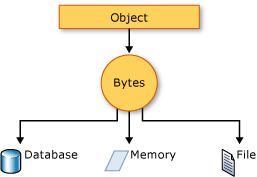
Serialization and Deserialization in Java with Example
Serialization is a mechanism of converting the state of an object into a byte stream. Deserialization is the reverse process where the byte stream is used to recreate the actual Java object in memory. This mechanism is used to persist the object.

The byte stream created is platform independent. So, the object serialized on one platform can be deserialized on a different platform.
To make a Java object serializable we implement the java.io.Serializable interface. The ObjectOutputStream class contains writeObject() method for serializing an Object.
public final void writeObject(Object obj)
throws IOException
The ObjectInputStream class contains readObject() method for deserializing an object.
public final Object readObject()
throws IOException,
ClassNotFoundException
Advantages of Serialization
- To save/persist state of an object.
- To travel an object across a network.

Only the objects of those classes can be serialized which are implementing java.io.Serializable interface. Serializable is a marker interface (has no data member and method). It is used to “mark” java classes so that objects of these classes may get certain capability. Other examples of marker interfaces are:- Cloneable and Remote.
Points to remember
- If a parent class has implemented Serializable interface then child class doesn’t need to implement it but vice-versa is not true.
- Only non-static data members are saved via Serialization process.
- Static data members and transient data members are not saved via Serialization process.So, if you don’t want to save value of a non-static data member then make it transient.
- Constructor of object is never called when an object is deserialized.
- Associated objects must be implementing Serializable interface.
Example :
class A implements Serializable{
// B also implements Serializable
// interface.
B ob=new B();
}
SerialVersionUID
The Serialization runtime associates a version number with each Serializable class called a SerialVersionUID, which is used during Deserialization to verify that sender and reciever of a serialized object have loaded classes for that object which are compatible with respect to serialization. If the reciever has loaded a class for the object that has different UID than that of corresponding sender’s class, the Deserialization will result in an InvalidClassException. A Serializable class can declare its own UID explicitly by declaring a field name. It must be static, final and of type long. i.e- ANY-ACCESS-MODIFIER static final long serialVersionUID=42L;
If a serializable class doesn’t explicitly declare a serialVersionUID, then the serialization runtime will calculate a default one for that class based on various aspects of class, as described in Java Object Serialization Specification. However it is strongly recommended that all serializable classes explicitly declare serialVersionUID value, since its computation is highly sensitive to class details that may vary depending on compiler implementations, any change in class or using different id may affect the serialized data.
It is also recommended to use private modifier for UID since it is not useful as inherited member.
serialver
The serialver is a tool that comes with JDK. It is used to get serialVersionUID number for Java classes. You can run the following command to get serialVersionUID
serialver [-classpath classpath] [-show] [classname…]

Example 1:
// Java code for serialization and deserialization
// of a Java object
import java.io.*;
class Demo implements java.io.Serializable
{
public int a;
public String b;
// Default constructor
public Demo(int a, String b)
{
this.a = a;
this.b = b;
}
}
class Test
{
public static void main(String[] args)
{
Demo object = new Demo(1, "geeksforgeeks");
String filename = "file.ser";
// Serialization
try
{
//Saving of object in a file
FileOutputStream file = new FileOutputStream(filename);
ObjectOutputStream out = new ObjectOutputStream(file);
// Method for serialization of object
out.writeObject(object);
out.close();
file.close();
System.out.println("Object has been serialized");
}
catch(IOException ex)
{
System.out.println("IOException is caught");
}
Demo object1 = null;
// Deserialization
try
{
// Reading the object from a file
FileInputStream file = new FileInputStream(filename);
ObjectInputStream in = new ObjectInputStream(file);
// Method for deserialization of object
object1 = (Demo)in.readObject();
in.close();
file.close();
System.out.println("Object has been deserialized ");
System.out.println("a = " + object1.a);
System.out.println("b = " + object1.b);
}
catch(IOException ex)
{
System.out.println("IOException is caught");
}
catch(ClassNotFoundException ex)
{
System.out.println("ClassNotFoundException is caught");
}
}
}
Output :
Object has been serialized
Object has been deserialized
a = 1
b = geeksforgeeks
Example 2:
// Java code for serialization and deserialization
// of a Java object
import java.io.*;
class Emp implements Serializable {
private static final long serialversionUID =
129348938L;
transient int a;
static int b;
String name;
int age;
// Default constructor
public Emp(String name, int age, int a, int b)
{
this.name = name;
this.age = age;
this.a = a;
this.b = b;
}
}
public class SerialExample {
public static void printdata(Emp object1)
{
System.out.println("name = " + object1.name);
System.out.println("age = " + object1.age);
System.out.println("a = " + object1.a);
System.out.println("b = " + object1.b);
}
public static void main(String[] args)
{
Emp object = new Emp("ab", 20, 2, 1000);
String filename = "shubham.txt";
// Serialization
try {
// Saving of object in a file
FileOutputStream file = new FileOutputStream
(filename);
ObjectOutputStream out = new ObjectOutputStream
(file);
// Method for serialization of object
out.writeObject(object);
out.close();
file.close();
System.out.println("Object has been serialized\n"
+ "Data before Deserialization.");
printdata(object);
// value of static variable changed
object.b = 2000;
}
catch (IOException ex) {
System.out.println("IOException is caught");
}
object = null;
// Deserialization
try {
// Reading the object from a file
FileInputStream file = new FileInputStream
(filename);
ObjectInputStream in = new ObjectInputStream
(file);
// Method for deserialization of object
object = (Emp)in.readObject();
in.close();
file.close();
System.out.println("Object has been deserialized\n"
+ "Data after Deserialization.");
printdata(object);
// System.out.println("z = " + object1.z);
}
catch (IOException ex) {
System.out.println("IOException is caught");
}
catch (ClassNotFoundException ex) {
System.out.println("ClassNotFoundException" +
" is caught");
}
}
}
Output:
Object has been serialized
Data before Deserialization.
name = ab
age = 20
a = 2
b = 1000
Object has been deserialized
Data after Deserialization.
name = ab
age = 20
a = 0
b = 2000
Description for Output:
You have seen while deserializing the object the values of a and b has changed. The reason being a was marked as transient and b was static. In case of transient variables:- A variable defined with transient keyword is not serialized during serialization process.This variable will be initialized with default value during deserialization. (e.g: for objects it is null, for int it is 0). In case of static Variables:- A variable defined with static keyword is not serialized during serialization process.This variable will be loaded with current value defined in the class during deserialization.
